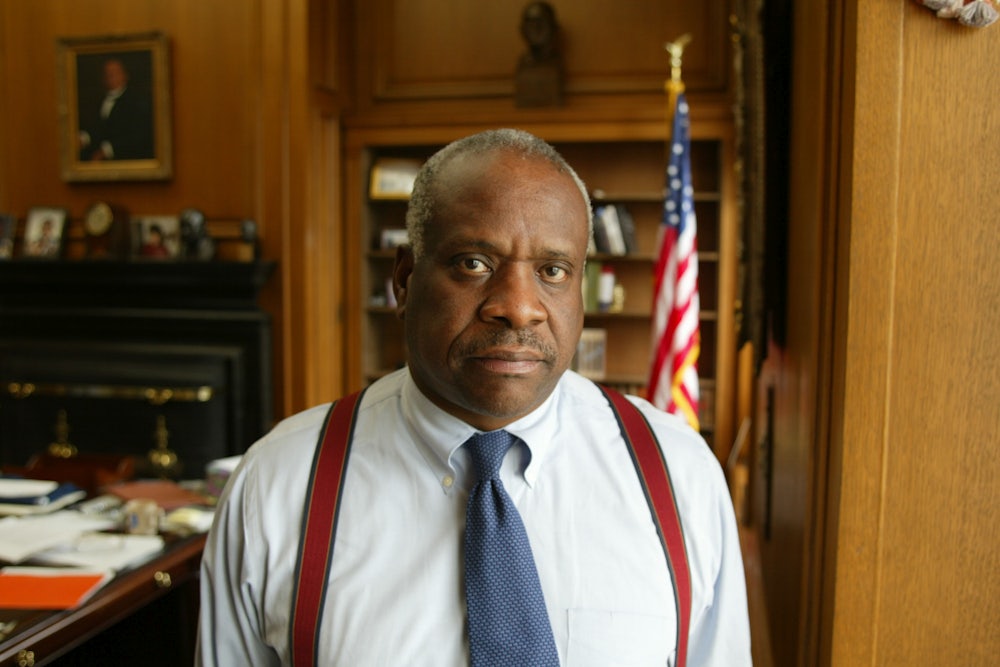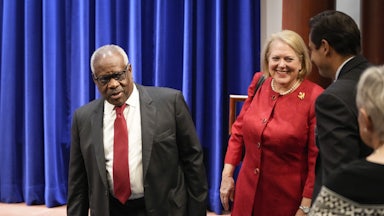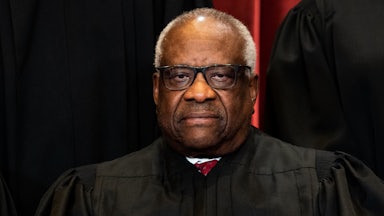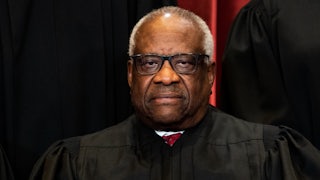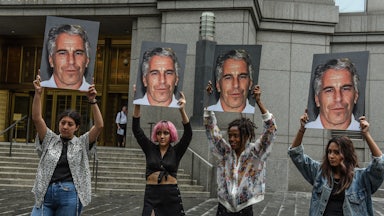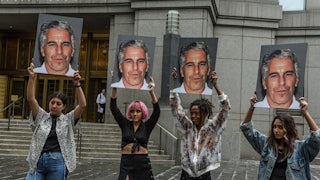Justice Clarence Thomas, the senior member of the ascendant wing of the Supreme Court, has some concerns. He is worried about the court’s perception among the American people as it turns further and further to the right. He is dismayed by the decline of the court’s internal trust and mutual respect after its soon-to-be ruling to overturn Roe v. Wade went public a few weeks ago. And he does not seem to appreciate his own role in bringing these circumstances about.
“What happened at the court was tremendously bad,” Thomas told a conservative legal conference in Dallas last week. He referred to the recent leak of Justice Samuel Alito’s draft opinion in Dobbs v. Jackson Women’s Health Organization, which offered a rare glimpse of a pending court decision—a preview of coming attractions in which Alito, Thomas, and three other justices are poised to overturn Roe v. Wade. “I wonder how long we’re going to have these institutions at the rate we’re undermining them,” he continued, describing the leak’s effect on the court’s internal dynamics. “And then I wonder, when they’re gone or destabilized, what we’re going to have as a country.”
It’s easy to share Thomas’s concerns about the stability of U.S. political institutions, even if you disagree with him on most other things. Public confidence in the various organs of American governance continues to ebb. Anti-constitutional and anti-democratic forces are growing in strength across the country. Just across the street from Thomas’s workplace two years ago, the sitting president incited a mob to attack Congress after the then vice president refused to unilaterally overturn the 2020 election. Thomas did not list the January 6, 2021, attack among his concerns, perhaps because his wife supported the protests that directly led to it and stoked the efforts to overturn the election that precipitated it.
Thomas has raised similar themes over the last month in his public and semi-public comments. In closed-door remarks to the Eleventh Circuit Court of Appeals judicial conference a few weeks ago, the court’s most senior justice said that he worried about the judiciary’s role in society if Americans can’t “live with outcomes we don’t agree with.” There are more than 330 million people living in the United States, and few of them are less well suited to make this point than Justice Clarence Thomas.
Supreme Court justices typically don’t say outright that they want to overturn a previous decision by the court. That would be too gauche, too legislative for the court. It would also effectively break their judicial oath to not prejudge cases. Instead, the most common formula is for them to write a concurring or dissenting opinion in a case on the same topic where they say that the court should “revisit” Decision X or Precedent Y “in an appropriate case.” Justices across the court’s ideological spectrum use this phrasing as a flare gun of sorts to highlight issues for their colleagues, for would-be litigators, and for the broader legal community.
In the 2019 case Gamble v. United States, the court held that the double jeopardy clause isn’t violated when a state government and the federal government each charge someone with a crime for the same underlying conduct. The majority declined to overturn a previous decision on the subject; Justice Neil Gorsuch, a frequent ally of Thomas on the court, criticized his colleagues’ refusal to do so in dissent. Breaking with Gorsuch, Thomas wrote a concurring opinion to explain his thoughts on stare decisis, a Latin phrase that essentially means deferring to the court’s previous decisions. That reliance on precedent to decide future cases is the bedrock of the common-law legal system that the U.S. inherited from its former English overlords.
It is also a principle of which Thomas is notoriously critical. By one count, he has written more than 250 times to call for previous Supreme Court decisions to be overturned or revisited. Some of those “revisitings” would upend the constitutional rights that most living Americans have known. In just the last few years, Thomas has suggested that the court should rethink decisions such as Gideon v. Wainwright, where the court held that indigent defendants must be provided a lawyer if they can’t afford one, and Obergefell v. Hodges, which extended the right to marriage to same-sex couples. When once asked about the difference between Thomas’s jurisprudence and his own, Scalia quipped, “I’m an originalist, but I’m not a nut.”
Writing in Gamble, Thomas accepted that jurists acting in good faith could reach different conclusions when reading ambiguous texts or constitutional provisions, and that this difference of opinion alone wasn’t enough to justify overturning a previous decision. But he also reiterated his stance that stare decisis didn’t apply when a prior decision’s reading of the Constitution was “demonstrably erroneous” in his eyes. “Whatever benefits may be seen to inhere in that approach—e.g., ‘stability’ in the law, preservation of reliance interests, or judicial ‘humility’—they cannot overcome that fundamental flaw,” he wrote, referring to the stare decisis justifications often used by his colleagues.
That’s what Thomas says about stare decisis in a formal Supreme Court opinion, at least. When speaking outside the court’s four walls, he’s somewhat more candid about his approach to precedent. “We use stare decisis as a mantra when we don’t want to think,” Thomas declared at an event earlier this month. And at the Dallas legal conference last week, he was even more blunt. “I always say that when someone uses stare decisis, that means they’re out of arguments,” Thomas remarked. “Now they’re just waving the white flag. And I just keep going.” His implication is that stare decisis isn’t actually an important principle in the American legal system—it’s just a crutch for idiots and losers.
One problem with this approach is that it runs counter to what most Americans expect from their federal courts. Congress and the executive branch have more leeway to write and rewrite the law because they can, at least in theory, be held accountable by voters for it. The same can’t be said for the federal judiciary in general and the Supreme Court in particular. Its members have life tenure, their salaries can’t be lowered during their term in office, and the taboo against removing them from office is so strong that Congress hasn’t seriously attempted it for more than 200 years. That insularity comes with the implicit understanding that the courts will use their immense power wisely, bounded by precedent and respect for the rule of law.
A casual observer of the court could also easily surmise that the justices’ rulings on abortion rights could be traced to their personal views on the matter. Thomas himself, for example, has previously compared proponents of abortion rights to those who supported eugenics in the early twentieth century, a stance that goes beyond merely believing that Roe was wrongly decided. Alito, as I noted earlier this month, hinted in his draft opinion that he favors the fetal-personhood argument put forward by the more aggressive wing of the anti-abortion legal movement. Justice Amy Coney Barrett took part in anti-abortion activism while working as a law professor at Notre Dame. And while Justices Neil Gorsuch and Brett Kavanaugh aren’t as open about their personal views on abortion, they were nominated by a president who campaigned on a pledge to appoint “pro-life judges” who would overturn Roe. Donald Trump isn’t known for keeping his promises, but on this one, he appears to have succeeded.
With Thomas, concerns about the influence of his personal views are particularly acute. “One of the things I’d say in response to the media is when they talk about, especially early on, about the way I did my job, I said, ‘I will absolutely leave the court when I do my job as poorly as you do yours,’” he remarked at the Dallas event. In 2019, Thomas urged the court to reconsider New York Times Co. v. Sullivan, a landmark First Amendment decision from 1964 that generally protects defendants from libel lawsuits brought by public figures in all but the most egregious cases. Overturning it would make it easier for public officials like Thomas to sue news outlets for what they perceive to be defamatory content. It’s hard not to wonder if Thomas’s personal experiences have influenced this conclusion.
Again, if Thomas held more normal beliefs about stare decisis, this wouldn’t really be an issue. But he has largely disavowed the idea that the Supreme Court has an inherent responsibility to be more cautious with precedent, and instead set forth a jurisprudence where the justices can overturn past decisions whenever they think their predecessors were mistaken. Thomas, in other words, is unwilling to abide by any reading of the Constitution that he thinks is “egregiously wrong.” He shouldn’t be surprised when most Americans take the same approach to Dobbs later this summer—and lose faith in the Supreme Court as an institution along the way.
